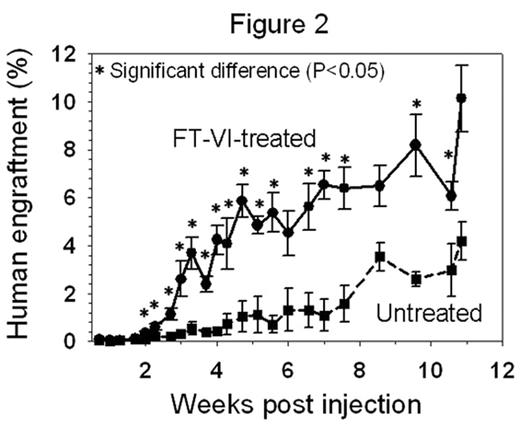Abstract
INTRODUCTION: Delayed engraftment following cord blood (CB) transplantation remains a major challenge. While cell dose is clearly limiting, CB-derived hematopoietic stem cells (HSC) also appear to have a deficit in homing and engraftment. CB HSC have low levels of surface fucosylation. Increasing the level of surface fucosylation might improve interactions with selectins expressed by the microvasculature of the hematopoietic microenvironment, potentially improving homing and engraftment.
METHODS: Human CB CD34+ were fucosylated using a recombinant fucosyltransferase (FTVI, Engraftin™, America Stem Cell, Inc., Carlsbad, CA) prior to injection into sublethally-irradiated NOD-SCID IL-2Rγnull mice. Levels of fucosylation were determined by flow cytometry using an anti-sialyl Lewis X antibody (a fucosylated selectin ligand). Each mouse received ∼4.5x104 CD34+ cells. The rate of engraftment was measured by the appearance of human CD45+ cells in the peripheral blood (PB). Following engraftment, multi-lineage reconstitution was measured (lymphoid, myeloid, platelet and erythroid). At termination (11 weeks post-transplant), levels of multi-lineage human engraftment were measured in PB, bone marrow (BM) and spleen.
RESULTS: 1% of CD34+ cells in non-fucosylated samples were heavily fucosylated as compared to >90% in the FTVI-treated sample, confirming that significant de novo fucosylation of CD34+ cells had occurred.(Fig 1) Human engraftment was detected in mice receiving CD34+ cells treated with FTVI ∼2 weeks after transplant, and by ∼3 weeks had reached >1%. In mice receiving non-FTVI-treated CD34+ cells, 1% human engraftment was only realized >4 weeks after transplant. By this time human engraftment in the mice receiving FTVI-treated cells was 5-fold higher.(Fig 2) At 11 weeks post transplant, human engraftment was present in both groups in PB (10±1% vs. 4±1%), BM (33±1% vs. 43±1%) and spleen (42±1% vs. 31±2%). Further, in both groups, evidence of a similar pattern of multi-lineage engraftment was observed in PB, BM and spleen.
CONCLUSION: These data suggest that increasing the levels of fucosylation of CB CD34+ cells using FTVI, dramatically improved the rate of engraftment, provided multi-lineage reconstitution and did not adversely effect long-term engraftment. This study supports further clinical development of fucosylation as a method of improving CB transplantation.
Author notes
Disclosure: No relevant conflicts of interest to declare.



This feature is available to Subscribers Only
Sign In or Create an Account Close Modal